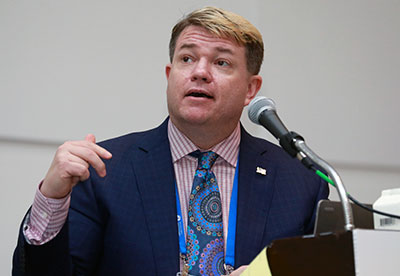Experts Highlight Community-Based Solutions to Help Break the Cycle of Gun Violence

This year’s Annual Meeting theme starts with the word “Disrupt,” and a Sunday session on youth and gun violence embraced that principle. For the session, Chair Stephan Carlson, M.D., featured some disruptive initiatives that communities can implement to address this seemingly intractable problem. Carlson (pictured above) is an assistant professor of psychiatry at New York Medical College.
Though many health care professionals focus on gun control measures—which Carlson said is an important policy discussion that psychiatrists should get behind—communities can look to other avenues to reduce gun violence without having to dive into the quagmire of public safety versus gun rights.
The first approach Carlson discussed is urban greening. The idea is to renovate vacant city lots into parks or other green space. It may seem like a minor cosmetic adjustment, but residents in inner-city communities frequently note that vacant lots are areas where gangs commonly congregate. For residents who live around the vacant areas, that means spending less time outside, less time socializing with neighbors, and less time being a community.
Some research in this area has shown that urban greening could reduce gun violence in a neighborhood by 39%. A similar approach known as urban de-blighting, which involves sprucing up abandoned houses to make them appear occupied, also resulted in a modest 8% reduction in gun violence.
The second strategy is based on principles of infection control, going along with the concept that gun violence is a disease of contagion. One strategy known as Cure Violence has been implemented in multiple cities. Carlson participated in a study of Cure Violence in the Brooklyn neighborhood of Brownsville from 2010 to 2013.
The goal is to prevent or at least minimize harmful gun violence exposure through proactive and reactive means. It involves training people with some forensic background to act as violence disruptors for a neighborhood. These disruptors are involved in community affairs, and when they come across a tense scene, they use their skills to de-escalate the situation before any guns are drawn. If gun violence does occur, the disruptors and other personnel work to get the community aware and involved positively by holding a neighborhood meeting to discuss the incident and working together to identify solutions to prevent repeat events. The Brooklyn program also offered access to mental health services to help individuals at risk of violence (proactive) as well as those who may have witnessed a violent encounter (reactive).
As with urban greening, Cure Violence has shown meaningful results. Carlson highlighted that the Brownsville project resulted in an 18% reduction in all homicides between 2010 and 2013. In comparison, the nearby Brooklyn neighborhood of Flatbush experienced a 69% increase in homicides during this same timeframe.
Carlson also found that the Cure Violence approach might produce more lasting effects. “There were significant behavioral shifts in that many youths no longer saw violence as an appropriate reaction to most disputes,” he said. “We were changing their social norms.”
(Image: David Hathcox)
|
|
|
|
|

